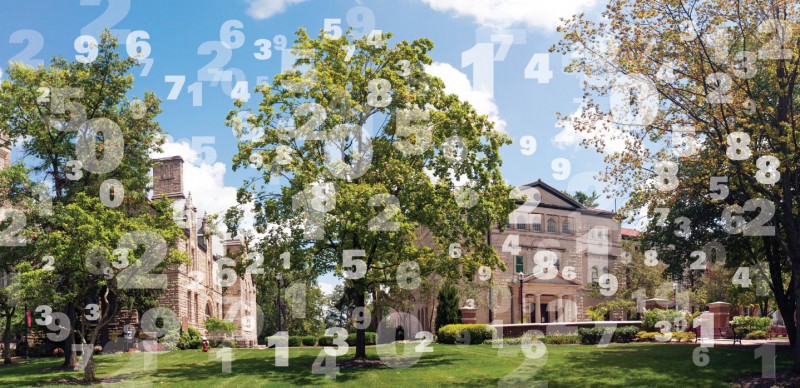Data on Campus: OWU and the Numbers Game


Imagine the demands of sorting through 40,000 to 50,000 inquiries a year from prospective students. That is exactly the challenge faced by Susan Dileno, Ohio Wesleyan vice president for enrollment, and the admission staff. Savvy use of data analytics helps them stay on track in their quest to ensure the best and brightest first-year classes possible for the University.
“Data analytics allows us to work more efficiently,” Dileno says, noting that a database of prospective students is used for predictive modeling that helps identify those most likely to apply to OWU and eventually enroll. The idea is to use all that data to build a list of about 5,000 top candidates and go from there; such a process resulted in a first-year class of 514 students in fall 2016.
In addition, OWU crunches external data it acquires to build a better understanding of what competing universities are experiencing in areas such as student retention rates, where their students come from, and what majors they choose. The University also examines data to identify factors that may contribute to students who apply to OWU choosing to attend other schools.
Dileno has been working in student admissions since 1987 and using data for predictive modeling for more than 15 years. “It’s funny, but I think data analytics is a new spin on an old practice,” she says. “It’s just that there are a lot of tools now to make it easier to retrieve and crunch the data. It’s a lot more seamless than it used to be.”
Data analytics is being deployed across OWU, including in athletics, budgeting, and predicting student retention and graduation rates.
In sports, Ohio Wesleyan coaches are using data analysis to identity factors that can help athletes improve their performance, says Mike Plantholt, the men’s lacrosse coach. The men’s and women’s lacrosse teams now use a company, Krossover Intelligence Inc., to analyze film and produce data on multiple aspects of player and team performance, including shooting percentages from various areas of the field.
Other teams, including football and baseball, use data analytics tools as well. “I really believe this is the science of sports today,” Plantholt says. “You’re looking for any intellectual or mathematical advantage you can to see what you’re doing well and not doing well.”
On the academic side, the most direct use of data analytics comes in making predictions about student retention and graduation rates, according to Associate Provost Dale Swartzentruber. He spends much of his time on data analytics projects of one sort or another.
As an example, he uses something called “logistic regression analysis” every semester to compare the success of students in different categories such as gender, ethnicity, and athletics after controlling for variables like high school grade-point averages and ACT/SAT scores. Swartzentruber also does exploratory types of analysis to see what role financial aid, co-curricular involvement, grades, and other factors play in student retention and graduation.
Data analytics work by him and others also plays a key role in the University’s budgeting process. For instance, recent historical averages for student retention rates, applications, admission rates, and tuition deposits help create a budget model that provides projections for five or more years, says Ben Emch, director of budget and accounting systems.
“Analytics for the incoming freshmen class is where the most data is used,” he says. “In the beginning of the budget process, we use the number of applications received along with historical admission rates/yields for each category of students to help us project how large the freshman class will be and to budget revenue accordingly.”
It is complicated stuff, but the University’s number crunchers say data analytics can help improve their chances of finding the right answers to the big questions of the day.
– Jeff Bell
